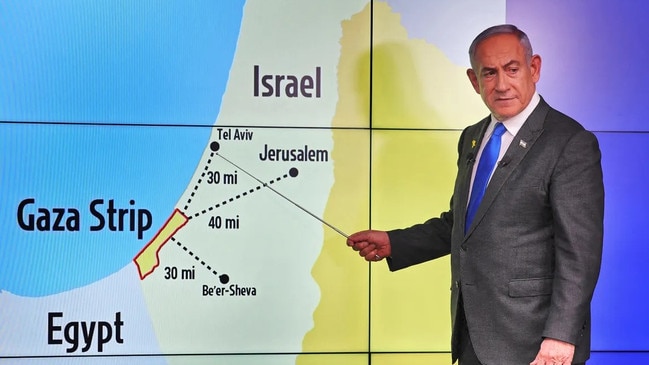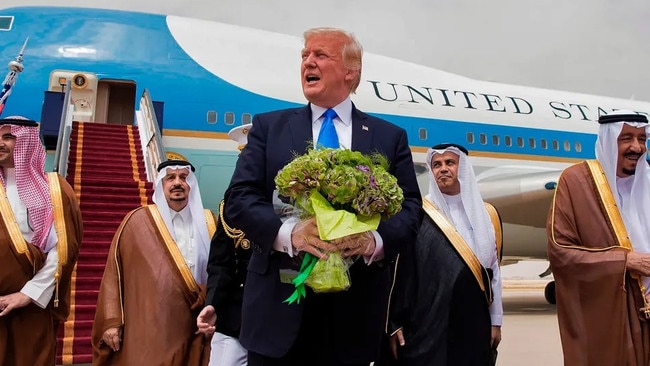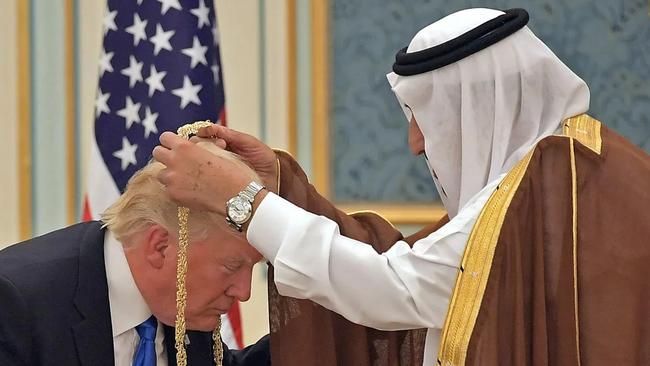Inside US rift over Mideast as Trump heads to his ‘happy place’
The US president visits the Gulf next week before Israel’s deadline for a Hamas ceasefire deal, with his cabinet split between hawks and doves on Iran.

There is an abiding image from President Donald Trump’s first-term visit to Saudi Arabia, of the businessman from Queens huddled alongside Middle Eastern leaders as they consult a mystical glowing orb.
In a region steeped in gesture and symbolism, speculation abounded as to whether it was some sort of an oracle offering a glimpse into the future – did it signal good fortune or impending doom?
Eight years later, the three men from that day – Trump, President Sisi of Egypt and King Salman of Saudi Arabia – face a leadership-defining challenge of dealing with the fallout of a devastating war in Gaza that has sent shockwaves across the world. The orb, it turned out, was an omen.
A lot is at stake before Trump’s tour of the United Arab Emirates, Saudi Arabia and Qatar next week.
Israel has set the end of the president’s trip as the deadline for a new hostage and ceasefire deal in Gaza and is threatening a massive operation to flatten and occupy the territory, displacing its entire population, if no deal is reached.
Israeli officials stress that the ultimatum to Hamas – to agree to the US-brokered framework, which includes the release of 10 hostages in exchange for a 45-day cessation of hostilities, before the end of the week –still stands.

In recent days, the Trump administration has expressed its belief to Israel that it can deliver. In contrast, Israeli officials told the Jerusalem Post that they see nothing to justify the American optimism.
Trump is working against the backdrop of divisions at home. Insiders tell The Times there are deep rifts in his team, roughly along the lines of hawks versus doves.
While JD Vance, vice-president, and Steve Witkoff, the Middle East envoy and “fixer”, have pushed for a detente with Iran through a new nuclear deal, a hardline approach has been urged by cabinet figures including Marco Rubio, the secretary of state, and Mike Waltz, the recently departed national security adviser.
Waltz is said to have been ousted from his role after meeting privately with the Israeli prime minister, Benjamin Netanyahu, in Washington earlier this year, and agreeing with the Israeli leader to pressure Trump to bomb Tehran.
There is growing daylight between Trump and Netanyahu as the administration tries to hash out a deal with its sworn enemy, Iran, and more recently over an agreement with the Iran-backed Houthi rebels not to attack US ships in the Gulf of Aden without also guaranteeing security for Israel.

Israeli media outlets carried a report on Friday claiming that Wiktoff told the families of Israeli hostages of Hamas this week that the ceasefire with the Houthis was “just the beginning” and should serve as a warning that Israel could soon find itself “alone” if it did not commit to the hostage-exchange deal.
“The cost of continuing this war will no longer fall solely on the hostages, it will now weigh heavily on Israel as a whole,” sources told Haaretz Witkoff had said. “The train is leaving the station and the United States will not be waiting.”
On Iran, “so far the doves are winning, mostly because they are more amenable to getting deals done, which is what the president ultimately wants”, one source close to the administration told The Times.
Before Trump takes off, Witkoff and his team were expected to hold another round of nuclear talks with Iran on Sunday in Oman. Gulf states are cautiously supportive of the administration’s outreach to the Islamic Republic, in part because they fear they would be the first casualties of any resulting war.
In making his first foreign trip to the Middle East rather than to neighbours Canada and Mexico – as has nearly every US leader since the World War II – Trump is eschewing unwritten presidential tradition. The move is a deliberate one, part of a much wider, strategic realignment in which the US prioritises the Gulf’s economic influence over North America’s trade and security ties.
It is no coincidence that all three of the president’s stops are home to Trump-branded properties or ongoing developments.
Last month, the Trump Organisation struck a deal for a Trump-affiliated golf course to be built north of the Qatari capital by a Saudi Arabian firm.
Meanwhile, Jared Kushner, his son-in-law who served as Trump’s adviser during his first term, has received $US2 billion ($3.1bn) in Saudi investment through his private equity fund, Affinity Partners, since leaving office in 2021.

During Trump’s 2017 visit to Riyadh, local Saudi media remarked how the president was treated like royalty: from his airport greeting by King Salman – a courtesy that was never extended to his predecessor, Barack Obama – and a military flyover and cannons that accompanied his descent from Air Force One to a lavish cardamom coffee ceremony at the Royal Court.
“It’s hard for me to escape the idea that President Trump is going to the Gulf because this is his happy place,” said John Alterman, senior vice-president of the Centre for Strategic and International Studies. “His hosts will be generous and hospitable. They’ll be keen to make deals. They’ll flatter him and not criticise him. And they’ll treat his family members as past and future business partners.”


In reality, however, much has changed since Trump’s first trip. The amount of leverage the US once had over Riyadh has greatly diminished. Trump had for years tried to convince Saudi Arabia to normalise ties with Israel by joining Gulf allies in signing the Abraham Accords, which was hailed as one of Trump’s chief foreign policy achievements.
Though Kushner is unlikely to join Trump on the trip, CNN reported he had been heavily involved in discussions with the kingdom’s leaders about signing on. The accords were about creating an axis against Iran, but Saudi-Iranian relations have been thawing for years, and Riyadh is far less concerned about the threat.
Meanwhile, a US offer to help see Saudi Arabia on a path to enriching civil nuclear energy is largely moot as Riyadh is on track to get much, if not all, of what it needs already.
The kingdom has repeatedly said it would not recognise Israel as part of the accords without a guarantee of a viable path to a Palestinian state.
There is little incentive for Riyadh to normalise with the most right-wing Israeli government in recent history, and at a time when a war on Gaza has ensured that Saudis, Arabs and Muslims worldwide would view such a move as unacceptable. Trump risks coming home with little material wins to show for his foreign foray, however he may spin it to suggest otherwise.
The Times





